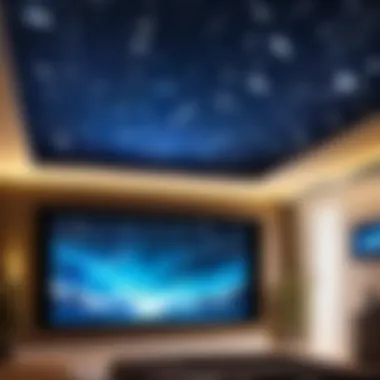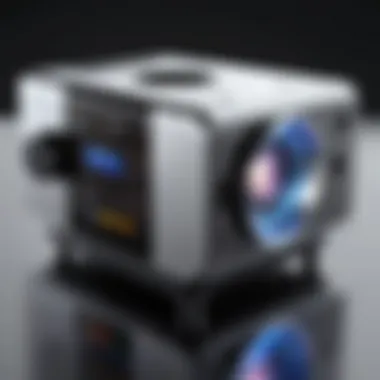Unlocking the Wonders of Music Star Projectors


Intro
Music star projectors have increasingly become a focal point in creating immersive atmospheres for various settings. These devices combine both visual and auditory elements, providing a unique experience that engages the senses. Individuals can easily elevate their environments with these projectors, whether in a cozy home setting or a vibrant event space.
Overview of the Product
Music star projectors are innovative devices designed to display captivating visuals while synchronized with audio. They create a blend of light and sound that transforms ordinary spaces into extraordinary environments.
Purpose and Benefits
The primary purpose of music star projectors is to enhance ambiance. They find applications in home decor, parties, meditation spaces, and even events. Benefits include:
- Mood Enhancement: The combination of stars and music can create a calming or energizing environment, depending on the user’s preference.
- Visual Appeal: The visual displays can turn an ordinary room into a stunning space, making it perfect for gatherings or relaxation.
- Versatility: Suitable for various settings, from children's bedrooms to adult entertainment areas.
Target Audience
The target audience for music star projectors includes:
- Families: Parents looking to create magical experiences for their kids.
- Couples: People who want to set a romantic or relaxing mood at home.
- Event Planners: Those seeking novel ways to enhance themed events.
- Meditation Enthusiasts: Individuals seeking peaceful environments for mindfulness practices.
Key Features
Key features of music star projectors vary by model, but commonly include:
- Light Patterns: Various display options, including stars, clouds, and themed projections.
- Sound Integration: Built-in speakers for music playback or the option to connect to external sound systems.
- Remote Control: Many devices offer the convenience of remote operation for ease of use.
- Timer Functions: Settings that allow users to automate the projector’s operation, perfect for sleep or relaxation time.
Music star projectors effectively combine technology and creativity, offering endless possibilities for enhancing ambient experiences.
Technical Specifications
Understanding the technical specifications is crucial for discerning tech enthusiasts. Features may include:
Detailed Product Specs
Typical specifications one might encounter include the following:
- Resolution: Quality of the visuals projected.
- Lumens: Brightness of light output.
- Connectivity Options: Bluetooth, Wi-Fi, or wired connections.
CPU Characteristics
The CPU often dictates the performance of the projector. Key characteristics may involve processing speed and efficiency in handling audio-visual data.
GPU Features
The GPU is essential for rendering complex visual patterns. Key features could include support for different graphic resolutions and rendering techniques.
Memory Details
Memory impacts the storage of audio tracks and visual patterns. Sufficient memory allows for smoother transitions and playback, enhancing user experience.
Performance Benchmarks
Performance can be evaluated through:
- Lumens per watt for energy efficiency.
- Sound quality ratings to assess the auditory experience.
Comparison with Similar Products
When considering a music star projector, it’s beneficial to compare with similar offerings in the market. This helps in making informed decisions.
Market Competitors
Key competitors may include brands like BlissLights and Homestar, each offering unique features and specifications geared toward enhancing user experience.
Comparative Analysis


A comparative analysis between competitors often reveals:
- Differences in audio playback quality.
- Variations in visual complexity and customization options.
- Price differences based on features and functionalities.
Best Use Cases
Different projectors excel in different environments. For example:
- Home use: Some projectors have softer light options, ideal for bedrooms.
- Events: Others may focus on brightness and complexity to dazzle audiences at parties.
Installation and Setup Guide
Setting up a music star projector can be an enjoyable task. Here are some practical steps.
Requirements for Installation
- Access to power outlets.
- Space for the projector, ideally with a direct view.
Step-by-Step Process
- Choose an appropriate location.
- Plug the projector into a power source.
- Set up the audio connection, if needed.
- Adjust the projector’s focus for optimal viewing.
Tips for Optimizing Setup
- Experiment with projection angles to achieve the desired effects.
- Use in darker spaces for enhanced visual experience.
Commonly Asked Questionss and Troubleshooting
Troubleshooting common issues can save time and frustration. Here are some frequent concerns.
Common Issues and Solutions
- Dim Projector Output: Adjust brightness settings or check the distance from the projection surface.
- No Sound: Ensure audio source is connected properly.
Expert Tips
- Regularly clean the lens for optimal projection clarity.
- Explore various light settings to suit different moods.
Prelims to Music Star Projectors
Music star projectors have become increasingly popular in recent years. They offer a unique combination of visual and auditory experiences. This blend creates immersive environments. Understanding their functionality is important for both personal enjoyment and professional uses.
Definition and Overview
Music star projectors are devices designed to project images of stars and other celestial objects onto ceilings and walls. They often include integrated sound systems, allowing users to enjoy music or nature sounds during the visual display. These projectors are often used in various settings, including homes, classrooms, and even therapy rooms. Their dual functionality enhances relaxation and stimulates imagination.
The charm of music star projectors lies in their ability to transform ordinary spaces into enchanting realms. For example, a simple living room can become a starry night sky, promoting a sense of peace and tranquility. These projectors can vary in features, depending on their intended use. Some projectors focus more on sound quality, while others emphasize the clarity and brightness of the projection.
Historical Context
The origin of music star projectors traces back to various forms of projection technology used in planetariums. Early planetarium projectors were large, intricate devices that simulated the night sky. As technology advanced, the concept was adapted for home use. The incorporation of sound into these devices emerged from a growing interest in multisensory experiences.
In the late 20th century, the first compact music star projectors were introduced to consumers. These devices typically featured basic star patterns and simple soundtracks. Today, manufacturers have utilized cutting-edge technology, making projectors more accessible and affordable for everyone. Modern projectors often come equipped with features like Bluetooth connectivity and mobile app integration, enhancing their appeal to tech enthusiasts.
The rise of music star projectors reflects a broader trend in consumer electronics towards creating environments that promote well-being and creativity. As people seek ways to escape daily stress, these devices provide a soothing escape. Whether for personal relaxation or professional settings, understanding the evolution of music star projectors highlights their growing importance in contemporary life.
Mechanics of Music Star Projectors
The mechanics of music star projectors serve as the core foundation of their functionality. These devices create visually engaging displays while synchronizing them with sound, thus enhancing the overall sensory experience. Understanding how they operate can significantly influence a user's decision-making process when selecting a projector.
Projection Technology
Projection technology is crucial in determining the quality of the visuals produced by music star projectors. Most models utilize LED or laser light sources, which provide bright and vivid displays. LED projectors tend to be energy-efficient and have a longer lifespan. However, laser projectors offer superior clarity and color accuracy, making them ideal for those serious about visual fidelity.
Different projection techniques can affect the scale of the display as well. Some projectors use lenses to create a wide-angle view, allowing users to fill larger spaces with starry visuals. Others employ diffraction grating, which slices the light to create intricate patterns of stars and nebulae, often resulting in a more enchanting experience.
Before purchasing, consider the projection range and focus capabilities. Some projectors may have fixed focus, while others allow for adjustment.


Sound Integration
Sound integration is another critical aspect of music star projectors. The ability to pair lights with audio enhances the overall sensory engagement. Most modern projectors come equipped with built-in speakers, able to play a variety of audio formats.
Higher-end models may support Bluetooth or Wi-Fi connectivity, allowing users to stream music directly from devices. This enhances versatility, letting users customize the atmosphere according to their preferences. It's also useful for presentations or educational settings, where synchronized sound and visuals can emphasize key points effectively.
“The combination of light and sound creates a multi-dimensional experience that is both immersive and educational.”
Furthermore, sound quality can vary significantly among different projectors. Testing the audio output before making a purchase can be worthwhile, especially if you plan to use the projector for events or gatherings where sound clarity is essential.
Control Mechanisms
Control mechanisms in music star projectors greatly influence usability. Many devices feature remote controls that allow users to easily adjust settings from a distance. This convenience can be particularly helpful during gatherings when frequent adjustments may be needed.
More advanced options include mobile applications that let users customize their experience. With a simple interface, users can control light patterns, audio tracks, and other effects directly from their smartphones. Many devices are also compatible with smart home systems, enhancing convenience by integrating into existing technology ecosystems.
Understanding which control mechanisms best suit your needs can simplify the user experience. If you’re tech-savvy and enjoy customization, look for projectors with expansive control options. On the other hand, if simplicity is your goal, select a model with straightforward, user-friendly controls.
Features and Specifications
Understanding features and specifications of music star projectors is crucial. These elements define the user experience and overall functionality. When selecting a projector, clarity in these specifications enables users to make informed decisions that align with their needs and expectations.
Light Quality and Types
Music star projectors often come with various light quality options. These options influence how effectively the projector creates visuals. Common types of lights used include LED, laser, and halogen. Each type presents distinct benefits. For example, LED lights are energy efficient and have a long lifespan, producing vibrant colors with minimal heat output. Conversely, laser projectors provide high brightness and exceptional color accuracy, making them ideal for larger spaces.
When evaluating light quality, consider:
- Lumens: A higher lumen count indicates a brighter projection, which can be critical in well-lit environments.
- Color Temperature: The warmth or coolness of the light can impact the ambience of the projection. A cooler color temperature can create a more stark effect, while warmer tones may produce a more inviting atmosphere.
Applications of Music Star Projectors
The applications of music star projectors extend beyond mere entertainment. These devices have find various roles in different environments. Understanding these applications helps in appreciating the value they add to both personal and shared experiences. The adaptability of music star projectors allows them to enhance atmosphere, create learning environments, and even act as a therapeutic tool. This section will discuss key uses including home entertainment, educational applications, and therapeutic uses.
Home Entertainment
Home entertainment experiences have evolved significantly with the advent of technology. Music star projectors can transform a simple room into a captivating experience. They provide ambient environments perfect for movie nights or parties. By projecting starry skies or vivid cosmic visuals along with synchronized music, they create an immersive backdrop that enhances the overall enjoyment.
- Versatile Lighting Effects: With customizable settings, users can select different themes and color patterns. This versatility invites creativity in setting up special occasions.
- Engagement: The combination of light and audio captivates audiences. Families can share memorable experiences together, whether it's a movie marathon or a simple gathering.
- Simple Setup: Most music star projectors are designed for easy installation. This user-friendly approach encourages more people to leverage their capabilities for entertainment.
Music star projectors redefine social interactions by integrating sound and visuals into shared experiences.
Educational Uses
In educational settings, music star projectors can enhance learning. Teachers can use these devices to create engaging visual aids. Students often respond better to lessons that include visual and auditory elements. By using music star projectors, educators can make lessons more interactive.
- Astronomy Lessons: They can visualize celestial bodies and constellations to aid learning in subjects like astronomy. This hands-on approach helps students grasp complex topics more effectively.
- Creative Arts: Art classes can leverage the ambient lighting these projectors create. Students can draw inspiration from the visuals projected, turning ordinary lessons into creative experiences.
- Mood Setting: With adjustable lighting, classrooms can shift the atmosphere to match the subject matter or the activity. This flexibility is important for focusing attention or evoking emotion.
Therapeutic Applications
Therapeutic settings are another crucial application for music star projectors. They can foster relaxation and help manage stress. The combination of soothing visuals and calming sounds offers a multi-sensory experience beneficial for various therapeutic practices.
- Stress Reduction: Many people find that immersive environments help in reducing anxiety. These projectors can serve as tools in therapeutic sessions, promoting calmness and focus.
- Occupational Therapy: Some programs include the use of sound and light to encourage engagement among participants. This can lead to improved outcomes in occupational therapy settings.
- Sleep Aids: Projectors can create peaceful environments for sleep. Gentle projections combined with calming music can help individuals drift off more easily.
In sum, the applications of music star projectors illustrate their multifaceted utility. Whether for enhancing home entertainment, promoting educational engagement, or fostering therapeutic environments, these devices enrich experiences. Their adaptability and visual contributions are essential for varied settings.
Considerations for Selection
When choosing a music star projector, various factors must be evaluated to ensure that the selected device meets specific needs. The importance of this selection process cannot be overstated. As the market grows, the diversity of options can be overwhelming. By focusing on essential elements, potential users can navigate this complexity more effectively.
Key Features to Look For
Identifying the right features in a music star projector is crucial for enhancing the user experience. Here are some significant features to consider:
- Projection Quality: The clarity and brightness of the projected images are vital. Look for projectors that use high-quality LEDs for a sharper image.
- Audio Capabilities: A projector that offers various audio output options, like Bluetooth connectivity, adds value for a more immersive experience.
- Customization Options: Some projectors come with adjustable settings for both light and sound. This flexibility allows users to tailor the environment to their preference.
- Ease of Use: User-friendly controls and interfaces can make a significant difference in overall satisfaction.


Budget and Brand Preferences
Budget is a defining factor in the selection of a music star projector. High-end options often promise superior quality and features but come at a premium price. Conversely, budget options may lack certain features but still provide a satisfactory user experience. Some considerations include:
- Value for Money: Examine the features against the price. Does the projector justify the cost?
- Brand Reputation: Established brands like BlissLights and Sega Toys often have reliable products with customer support. Researching brand history and reliability can guide you in making an informed decision.
- Warranty and Support: A good warranty can provide peace of mind. Check if the brand offers substantial support should any issue arise.
User Reviews and Ratings
User reviews and ratings provide invaluable insights into the real-world performance of a music star projector. Consider the following:
- Overall Ratings: A high average rating is generally indicative of quality. Assess how many ratings contribute to this average.
- Specific Feedback: Reading through user comments can highlight both strengths and potential shortcomings.
- Longevity of Use: Consider reviews that discuss long-term usage. Are projectors failing after a short time, or do they remain functional for years?
Important to note: Taking time to read reviews from multiple sources can paint a clearer picture of the product's overall quality.
Installation and Setup
The proper installation and setup of music star projectors are crucial for optimizing their performance and achieving the best visual and auditory experience. Whether using the projector for personal enjoyment, educational purposes, or therapeutic applications, taking the time to ensure correct setup can greatly enhance the overall functionality. Proper placement and configuration can impact how well the device projects visuals, as well as how sound is integrated into the environment. As such, understanding the specific requirements and setup instructions is essential.
Space Requirements
When considering space requirements for music star projectors, several factors must be taken into account. The area available for projection directly affects the quality of the experience. Here are key elements to evaluate:
- Room Size: The dimensions of the room determine how far the projector needs to be placed from the wall or ceiling. A larger room may require a projector with a higher lumen output to ensure visibility of the projections.
- Projection Surface: The type of surface where the images will be cast also matters. Ideally, a smooth and light-colored surface will offer better clarity. Walls, ceilings, or special projection screens can be suitable.
- Height of Ceiling: For devices designed to project upwards, it's important to measure the ceiling height. Maintaining optimal distance from the projection surface ensures the visuals are seen clearly without distortion.
- Ambient Light: Consideration of the amount of light present in the room is vital. Ambient light can wash out the visuals, thus reducing the effectiveness of the projector. Darker rooms typically provide a more immersive experience.
By assessing these factors, users can determine the best configurations and locations for their music star projectors, maximizing their functionality and effects.
Technical Setup Instructions
Once the space requirements are addressed, the next focus turns to the technical setup. Following proper setup instructions ensures that the projector operates seamlessly. Here are important steps to take:
- Unboxing and Inspection: Carefully unbox the projector and check for any damages or missing parts. Ensure all accessories, including power cables and remotes, are present.
- Placement: Position the projector according to the previously assessed requirements. Ensure it is stable and securely placed to prevent any vibrations that could cause distortion.
- Power Connection: Connect the projector to an appropriate power source. Ensure that the power outlet can handle the voltage requirements of the device.
- Audio Setup: If the projector includes built-in speakers or allows for external audio connections, ensure that the sound output is configured correctly. Adjust the volume settings for optimal sound experience.
It's crucial to refer to the specific product manual for detailed instructions tailored to the particular model in use. Each projector may have unique features demanding specific setup configurations.
- Testing: Once everything is connected and set up, conduct a test run. Project different visuals while playing audio to ensure everything works properly and meets your expectations.
By carefully following these setup instructions, you increase the chances of enjoying the immersive environments that music star projectors are designed to create.
Maintenance and Troubleshooting
Maintaining music star projectors is essential for ensuring optimal functionality and longevity. As with any electronic devices, neglecting maintenance can lead to decreased performance or even irreversible damage. In this section, we address the importance of regular upkeep and the common issues users may encounter, along with their solutions. This guidance can help users avoid the hassle of more significant repairs or even replacements down the line.
Regular Maintenance Practices
To maintain the integrity of music star projectors, communication about best practices is necessary. Below are some recommended maintenance practices:
- Cleaning the Lens: Dust and fingerprints can accumulate on the projector lens, affecting image clarity. Use a microfiber cloth to gently wipe the lens without applying too much pressure.
- Checking Cables and Connections: Over time, cables can wear down or become loose. Regularly inspect all cables for signs of damage and ensure they are securely connected.
- Updating Firmware: Some models, like the BlissLights Sky Lite, offer firmware updates that enhance functionality. Regular updates can fix bugs or add new features, keeping your projector running smoothly.
- Proper Storage: When not in use, store the projector in a cool, dry place and use the original packaging if possible. This can prevent physical damage and protect it from dust.
By implementing these practices, one can ensure that the projector performs at its best and last longer, providing an immersive visual and auditory experience.
Common Issues and Solutions
Despite best efforts at maintenance, users may still experience some issues. Here are a few common problems and their solutions:
- Problem: Dim Projection
Solution: If the projection appears dim, it may be due to dust on the lens. Clean it with a suitable cloth. If that does not work, check if the bulb needs replacement or if the settings are adjusted to low brightness. - Problem: No Sound Output
Solution: Make sure the audio cable is properly connected and the volume settings are adjusted correctly. If the projector is paired with a Bluetooth device, ensure that it is connected. - Problem: Device Not Responding
Solution: This can happen due to software glitches. Restart the projector and, if necessary, perform a factory reset after consulting the user manual.
Keeping your music star projector in optimal condition is vital not just for performance, but also for maintaining the visual appeal that makes these devices so enjoyable.
By being aware of these maintenance practices and common troubleshooting techniques, users can have a more gratifying experience with their projectors. Investing time into caring for devices pays off in enhanced performance and longevity, ultimately creating better environments for relaxation and enjoyment.
Epilogue
The study of music star projectors reveals significant aspects of their functionality and benefits to various users. Understanding these devices is crucial for both personal enjoyment and practical applications. They offer immersive experiences that combine captivating visuals and engaging sounds.
Summary of Key Points
- Technology Overview: Music star projectors use innovative projection technology to create a mesmerizing starry ambiance, enriching environments in homes and professional spaces.
- Sound Integration: These devices not only visualize ambiance but also synchronize with music, which enhances the interactive experience and offers diverse audio output options.
- Applications: From home entertainment to educational settings, music star projectors serve multiple functions. They can aid relaxation in therapeutic contexts and enhance the learning atmosphere in classrooms.
- Considerations for Selection: When choosing a projector, individuals should prioritize key features like light quality, connectivity options, and brand reliability.
- Maintenance Needs: Regular upkeep ensures longevity and optimal performance of the music star projectors, preventing common issues that users may encounter.
Future Trends in Music Star Projection
The future of music star projectors is promising, with advancing technology likely to reshape this niche. Some trends to watch include:
- Advanced Technology: Newer models may utilize higher resolution and more vibrant colors to create stunning visuals.
- Smart Home Integration: The ability to connect with smart home devices may increase, offering more control over the environment through voice commands and app integration.
- Sustainability: Future projectors may focus on energy efficiency and eco-friendly materials as environmental awareness grows among consumers.
- Customization Features: The trend leans towards offering users more customization options, from light patterns to soundscapes, empowering them to create unique experiences.



